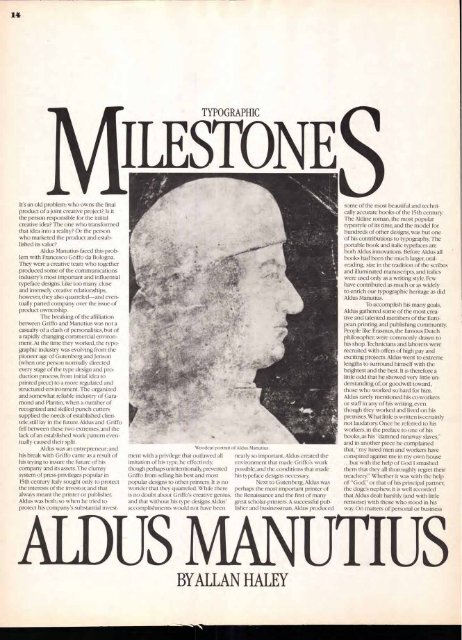Volume 12–4 (Low Res).pdf - U&lc
Volume 12–4 (Low Res).pdf - U&lc
Volume 12–4 (Low Res).pdf - U&lc
Create successful ePaper yourself
Turn your PDF publications into a flip-book with our unique Google optimized e-Paper software.
14<br />
It's an old problem: who owns the final<br />
product of a joint creative project?_Is it<br />
the person responsible for the initial<br />
creative idea? The one who transformed<br />
that idea into a reality? Or the person<br />
who marketed the product and established<br />
its value?<br />
Aldus Manutius faced this problem<br />
with Francesco Griffo da Bologna.<br />
They were a creative team who together<br />
produced some of the communications<br />
industry's most important and influential<br />
typeface designs. Like too many close<br />
and intensely creative relationships,<br />
however, they also quarreled—and eventually<br />
parted company over the issue of<br />
product ownership.<br />
The breaking of the affiliation<br />
between Griffo and Manutius was not a<br />
casualty of a clash of personalities, but of<br />
a rapidly changing commercial environment.<br />
At the time they worked, the typographic<br />
industry was evolving from the<br />
pioneer age of Gutenberg and Jenson<br />
(when one person normally directed<br />
every stage of the type design and production<br />
process, from initial idea to<br />
printed piece) to a more regulated and<br />
structured environment. The organized<br />
and somewhat reliable industry of Garamond<br />
and Plantin, when a number of<br />
recognized and skilled punch cutters<br />
supplied the needs of established clientele,<br />
still lay in the future. Aldus and Griffo<br />
fell between these two extremes, and the<br />
lack of an established work pattern eventually<br />
caused their split.<br />
Aldus was an entrepreneur; and<br />
his break with Griffo came as a result of<br />
his trying to insure the future of his<br />
company and its assets. The clumsy<br />
system of press-privileges popular in<br />
15th century Italy sought only to protect<br />
the interests of the investor, and that<br />
always meant the printer or publisher.<br />
Aldus was both; so when he tried to<br />
protect his company's substantial invest-<br />
ILESTONE<br />
TYPOGRAPHIC<br />
ment with a privilege that outlawed all<br />
imitation of his type, he effectively,<br />
though perhaps unintentionally, prevented<br />
Griffo from selling his best and most<br />
popular designs to other printers. It is no<br />
wonder that they quarreled. While there<br />
is no doubt about Griffo's creative genius,<br />
and that without his type designs Aldus'<br />
accomplishments would not have been<br />
nearly so important, Aldus created the<br />
environment that made Griffo's work<br />
possible, and the conditions that made<br />
his typeface designs necessary.<br />
Next to Gutenberg, Aldus was<br />
perhaps the most important printer of<br />
the Renaissance and the first of many<br />
great scholar-printers. A successful publisher<br />
and businessman, Aldus produced<br />
some of the most beautiful and technically<br />
accurate books of the 15th century.<br />
The Aldine roman, the most popular<br />
typestyle of its time, and the model for<br />
hundreds of other designs, was but one<br />
of his contributions to typography. The<br />
portable book and italic typefaces are<br />
both Aldus innovations. Before Aldus all<br />
books had been the much larger, oral-<br />
reading, size in the tradition of the scribes<br />
and illuminated manuscripts, and italics<br />
were used only as a writing style. Few<br />
have contributed as much or as widely<br />
to enrich our typographic heritage as did<br />
Aldus Manutius.<br />
To accomplish his many goals,<br />
Aldus gathered some of the most creative<br />
and talented members of the European<br />
printing and publishing community.<br />
People like Erasmus, the famous Dutch<br />
philosopher, were commonly drawn to<br />
his shop. Technicians and laborers were<br />
recruited with offers of high pay and<br />
exciting projects. Aldus went to extreme<br />
lengths to surround himself with the<br />
brightest and the best. It is therefore a<br />
little odd that he showed very little understanding<br />
of, or goodwill toward,<br />
those who worked so hard for him.<br />
Aldus rarely mentioned his co-workers<br />
or staff in any of his writing, even<br />
though they worked and lived on his<br />
premises. What little is written is certainly<br />
not laudatory. Once he referred to his<br />
workers, in the preface to one of his<br />
books, as his "damned runaway slaves,"<br />
and in another piece he complained<br />
that, "my hired men and workers have<br />
conspired against me in my own house<br />
...but with the help of God I smashed<br />
them that they all thoroughly regret their<br />
treachery" Whether it was with the help<br />
of "God," or that of his principal partner,<br />
the doge's nephew, it is well recorded<br />
that Aldus dealt harshly (and with little<br />
remorse) with those who stood in his<br />
way. On matters of personal or business<br />
ALDUS mANunus<br />
BYALLAN HALEY
















